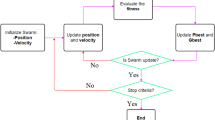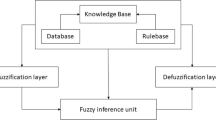Abstract
Open-pit mining has several non-deterministic polynomial-time hard (NP-hard) 0–1 knapsack problems. The complexities of these problems are also increased due to some uncertain input parameters. This paper proposed an innovative hybrid fuzzy logic and genetic algorithm-based approach for solving a critical open-pit mining problem. First, the uncertainty of this problem is incorporated within the type-2 fuzzy environment, where the critical value reduction method was used to defuzzify the objective value. Next, genetic algorithm was used to solve the optimisation problem iteratively using a special initial solution generator, unique mutation, refinement, and immigration operations. Some benchmark instances from KPLIB were solved to show the effectiveness of the proposed hybrid fuzzy type-2 and genetic algorithm approach. The benchmark results show the proposed method can generate optimum solutions. Finally, a few OPMP instances from MineLib were solved using the proposed technique to demonstrate the applicability of this research to actual cases under fuzziness. The case study results indicated that the proposed approach can effectively solve the open-pit optimisation problem and similar NP-hard knapsack problems.


Similar content being viewed by others
Data availability
This research uses open source data. The source of data is highlighted within the text with appropriate references.
Code availability
Codes are available from the first author upon request with suitable justification.
References
Abboud NJ, Sakawa M, Inuiguchi M (1997) A fuzzy programming approach to multi-objective multi-dimensional 0–1 knapsack problems. Fuzzy Sets Syst 86:1–14
Abdullah L, Najib L (2014) A new type-2 fuzzy set of linguistic variables for the fuzzy analytic hierarchy process. Expert Syst Appl 41(7):3297–3305
Asad MWA, Dimitrakopoulos R (2013) Implementing a parametric maximum flow algorithm for optimal open pit mine design under uncertain supply and demand. J Operat Resear Soci 64:185–197
Asad MWA, Dimitrakopoulos R, Eldert JV (2014) Stochastic production phase design for an open pit mining complex with multiple processing streams. Eng Optim 46(8):1139–1152
Bakirli BB, Gencer C, Aydogan EK (2014) A combined approach for fuzzy multi-objective multiple knapsack problems for defence project selection. J Operat Resear Soci 65:1001–1016
Boland N, Dumitrescu I, Froyland G, Gleixner AM (2009) LP-based disaggregation approaches to solving the open pit mining production scheduling problem with block processing selectivity. Comput Oper Res 36(4):1064–1089
Boucher A, Dimitrakopoulos R (2012) Multivariate block-support simulation of the Yandi iron ore deposit Western Australia. Math Geosci 44(4):449–468
Chatterjee S, Dimitrakopoulos R (2020) “Production scheduling under uncertainty of an open-pit mine using Lagrangian relaxation and branch-and-cut algorithm.” Int J Min Reclam Environ 34(5):343–361
Chatterjee S, Dimitrakopoulos R, Mustapha H (2012) Dimensional reduction of pattern-based simulation using wavelet analysis. Math Geosci 44(3):343–374
Chatterjee S, Sethi MR, Asad MWA (2016) Production phase and ultimate pit limit design under commodity price uncertainty. Eur J Oper Res 248(2):658–667
Dimitrakopoulos R, Farrelly CT, Godoy M (2002) Moving forward from traditional optimisation: grade uncertainty and risk effects in open pit design. Min Technol 111:A82–A88
Espinoza D, Goycoolea M, Moreno E (2015) The precedence constrained knapsack problem: separating maximally violated inequalities. Discret Appl Math 194:65–80
Espinoza D, Goycoolea M, Moreno E, Newman A (2013) MineLib: a library of open pit mining problems. Ann Oper Res 206:93–114
Feng Y, Wang GG, Gao XZ (2016) A novel hybrid cuckoo search algorithm with global harmony search for 0–1 knapsack problems. Int J Computat Intell Sys 9:1174–1190
Gao X, Sun Q, Xu H, Gao J (2020) Sparse and collaborative representation based kernel pairwise linear regression for image set classification. Expert Syst Appl 140:112886
Gong Y, Xiang L, Yang S, Ma H (2020) A new method for ranking interval type-2 fuzzy numbers based on Mellin transform. Internat J Uncert Fuzz Knowl-Based Sys 28(04):591–611
Goovaert P (1997) Geostatistics for natural resources evaluation. Applied Geostatistics Series, New York
Gu XW, Qing W, Ge S (2010) Dynamic phase-mining optimisation in open-pit metal mines. Trans Nonferr Metal Soci China 20:1974–1980
Hung W, Yang M (2004) Similarity measures between type-2 fuzzy sets. Int J Uncertain Fuzz Knowl-Based Sys 12(06):827–841
Irmeilyana I, Bangun P, Izzah H (2017) Solution of multiple constraints knapsack problem (MCKP) by using branch and bound method and greedy algorithm. J Model Optimiz 9:112–119
Khalili-Damghani K, Nojavan M, Tavana M (2013) Solving fuzzy multi-dimensional multiple-choice knapsack problems: the multi-start partial bound enumeration method versus the efficient epsilon-constraint method. Appl Soft Comput 13:1627–1638
King B, Goycoolea M, Newman A (2017) Optimising the open pit-to-underground mining transition. Eur J Oper Res 257:297–309
Kumar A, Chatterjee S (2017) “Open-pit coal mine production sequencing incorporating grade blending and stockpiling options”, An application from an Indian mine. Eng Optimis 49(5):762–776
Kundu P, Kar S, Maiti M (2015) Multi-item solid transportation problem with type-2 fuzzy parameters. Appl Soft Comput 31:61–80
Lamghari A, Dimitrakopoulos R (2012) A diversified Tabu search approach for the open-pit mine production scheduling problem with metal uncertainty. Eur J Oper Res 222(3):642–652
Lamghari A, Dimitrakopoulos R, Ferland JA (2015) A hybrid method based on linear programming and variable neighbourhood descent for scheduling production in open-pit mines. J Global Optim 63(3):555–582
Lin G, Zhu W, Ali MM (2011) An exact algorithm for the 0–1 linear knapsack problem with a single continuous variable. J Global Optim 50:657–673
Liu SQ, Kozan E (2016) New graph-based algorithms to efficiently solve large scale open pit mining optimisation problems. Expert Syst Appl 43:59–65
Liu Z, Lu Y, Lai Z, Ou W, Zhang K (2021) Robust sparse low-rank embedding for image dimension reduction. Appl Soft Comput 113:107907
Mahapatra NK, Bhunia AK, Maiti MA (2005) multi-objective wholesaler-retailers’ problem via a genetic algorithm. J Appl Math Comput 19:397–414
Michalewicz Z (1996) Genetic algorithms + data structures = evolution programs. Springer, Berlin
Moreno E, Espinoza D, Goycoolea M (2010) “Large-scale multi-period precedence constrained knapsack problem”, A mining application. Electr Notes Discret Math 36:407–414
Paithankar A, Chatterjee S (2019) Open-pit mine production schedule optimisation using a hybrid of maximum-flow and genetic algorithms. Appl Soft Comput 81:105507
Paithankar A, Chatterjee S, Goodfellow R (2020) Open-pit mining complex optimisation under uncertainty with integrated cut-off grade based destination policies. Resour Policy 70:101875
Qin R, Liu YK, Liu ZQ (2011) Methods of critical value reduction for type-2 fuzzy variables and their applications. J Comput Appl Math 235:1454–1481
Ramazan S (2007) The new fundamental tree algorithm for production scheduling of open pit mines. Eur J Oper Res 177(2):1153–1166
Ramazan S, Dimitrakopoulos R (2013) Production scheduling with uncertain supply: a new solution to the open pit mining problem. Optim Eng 14(2):361–380
Revuelta EC, Chavez MJ, Vera JAB, Rodriguez YF, Sanchez MC (2001) Optimisation of laser scanner positioning networks for architectural surveys through the design of genetic algorithms. Measurement 174:108898
Rommelfanger H (2004) The advantages of fuzzy optimisation models in practical use. Fuzzy Optim Decis Making 3(4):295–309
Sabba S, Chikhi S (2014) A discrete binary version of bat algorithm for multi-dimensional knapsack problem. Int J Bio-Insp Comput 6:140–152
Sadeghi J, Sadeghi S, Niaki STA (2014) Optimising a hybrid vendor-managed inventory and transportation problem with fuzzy demand: an improved particle swarm optimisation algorithm. Inf Sci 272:126–144
Samavati M, Essam D, Nehring M, Sarker R (2017) A methodology for the large-scale multi-period precedence-constrained knapsack problem: an application in the mining industry. Int J Prod Econ 193:12–20
Souza MJF, Coelho IM, Ribas S, Santos HG, Merschmann LHC (2010) A hybrid heuristic algorithm for the open-pit-mining operational planning problem. Eur J Oper Res 207:1041–1051
Tachefine B, Soumis F (1997) Maximal closure on a graph with resource constraints. Comput Oper Res 24(10):981–990
Wang S, Cui W, Chu F, Yu J (2020) The interval min-max regret knapsack packing-delivery problem. Int J Prod Resear. https://doi.org/10.1080/00207543.2020.1789235
Xing LN, Chen YW, Yang KW, Hou F, Shen XS, Cai HP (2008) A hybrid approach combining an improved genetic algorithm and optimisation strategies for the asymmetric travelling salesman problem. Eng Appl Artif Intell 21:1370–1380
You B, Yamada T (2007) A pegging approach to the precedence-constrained knapsack problem. Eur J Oper Res 183:618–632
Zhou X, Tu Y, Han J, Xu J, Ye X (2017) A class of level-2 fuzzy decision-making model with expected objectives and chance constraints: application to supply chain network design. Int J Inf Technol Decis Mak 16(04):907–938
Zhu F, Gao J, Yang J, Ye N (2022) Neighborhood linear discriminant analysis. Pattern Recogn 123:108422
Zhu F, Ning Y, Chen X, Zhao Y, Gang Y (2021) On removing potential redundant constraints for SVOR learning. Appl Soft Comput 102:106941
Zhu L, Zhao R, Wansheng T (2013) Fuzzy single-period product problem with return policy. Int J Manag Sci Eng Manag 2:126–137
Zou D, Gao L, Li S, Wu J (2011) Solving 0–1 knapsack problem by a novel global harmony search algorithm. Appl Soft Comput 11:1556–1564
Funding
This work is not associated with any funding source to declare.
Author information
Authors and Affiliations
Contributions
RKP, SC, and SKS conceptualised the problem, AP wrote the codes and ran tests, and CC executed fuzzy implementation of the codes. SC prepared mining benchmark data. AP and AK drafted the manuscript; all authors edited the manuscript.
Corresponding author
Ethics declarations
Conflict of interest
Authors declare that they have no conflicts of interest.
Consent to participate
All authors have consented to participate in this research.
Consent for publication
All authors have consented to publish this research.
Additional information
Publisher's Note
Springer Nature remains neutral with regard to jurisdictional claims in published maps and institutional affiliations.
Rights and permissions
Springer Nature or its licensor (e.g. a society or other partner) holds exclusive rights to this article under a publishing agreement with the author(s) or other rightsholder(s); author self-archiving of the accepted manuscript version of this article is solely governed by the terms of such publishing agreement and applicable law.
About this article
Cite this article
Pramanik, A., Changdar, C., Khan, A. et al. A 0–1 knapsack problem-based approach for solving open-pit mining problem with type-2 fuzzy parameters. Innovations Syst Softw Eng (2022). https://doi.org/10.1007/s11334-022-00491-1
Received:
Accepted:
Published:
DOI: https://doi.org/10.1007/s11334-022-00491-1




